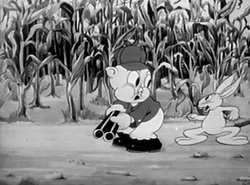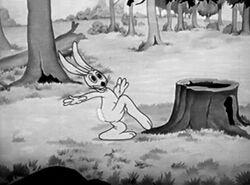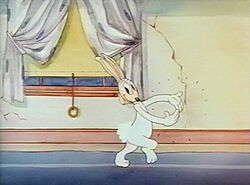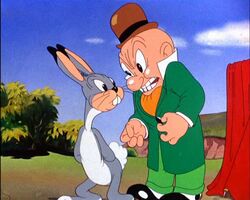
Porky Pig meets the Rabbit in Porky's Hare Hunt
Happy Rabbit is a character from the Looney Tunes and Merrie Melodies series who later evolved into the Warner Bros. cartoon studio's most famous character, Bugs Bunny. Created by Ben "Bugs" Hardaway in 1938, Happy Rabbit first appeared in the short Porky's Hare Hunt.
Like most of the other Looney Tunes characters, Happy Rabbit was voiced by Mel Blanc. No one remembered the name of the Bugs Bunny prototype until Blanc spoke of Bugs' origins in a 1970s interview.
History

The Rabbit runs from Porky Pig in Porky's Hare Hunt.
Happy Rabbit made his screen debut in the 1938 Looney Tunes cartoon Porky's Hare Hunt, directed by Ben Hardaway. Similar in tone and execution to the previous year's Porky's Duck Hunt, which introduced Daffy Duck, Porky's Hare Hunt involves Porky hunting a white rabbit whose wild antics drive him mad. Mel Blanc would later use his "Happy Rabbit" voice characterization as the voice of Walter Lantz's Woody Woodpecker.

Happy Rabbit in Prest-O Change-O
Chuck Jones used Happy Rabbit as a foil in his 1939 short, Prest-O Change-O, which marked the rabbit's second appearance.

The redesigned Happy Rabbit in Hare-um Scare-um.
Happy was the focal point of his fourth cartoon, Hare-um Scare-um (1939), for which he was redesigned as a grey rabbit with large buck teeth.

Elmer and Happy in Elmer's Candid Camera
Happy Rabbit made his sixth appearance in Elmer's Candid Camera (1940), a cartoon which marked the first appearance of the "official" version of Elmer Fudd. The cartoon set into play the antagonistic relationship that would develop between Elmer and Happy's successor, Bugs Bunny, over the years. Throughout Elmer's Candid Camera, Happy Rabbit is very similar in appearance and personality to to Bugs; the only major differences between the two were that Happy had apricot-colored gloves and muzzle, a furrier tail, a black nose, black-tipped ears, and a different voice.
Happy appeared one last time with a cameo role in 1940's Patient Porky. The same year, Tex Avery directed A Wild Hare, a cartoon featuring Elmer Fudd hunting a rabbit, he had Happy Rabbit redesigned and revised with a new personality. The resulting rabbit character was given a new name - Bugs Bunny - in Chuck Jones' 1941 follow-up to A Wild Hare, Elmer's Pet Rabbit.
Template:Wikiquote
Template:Characters
